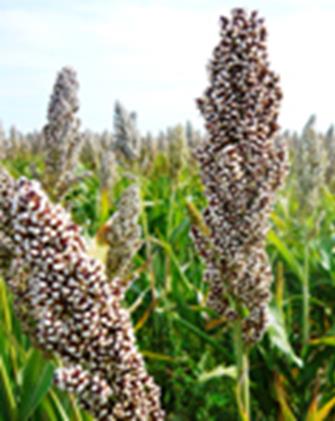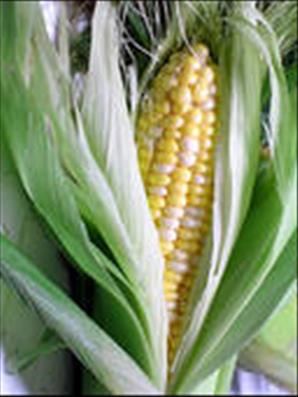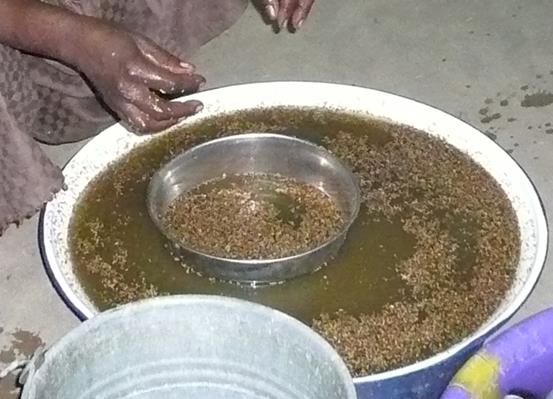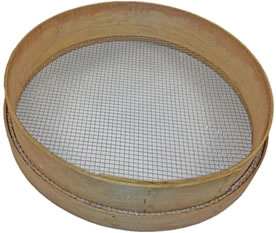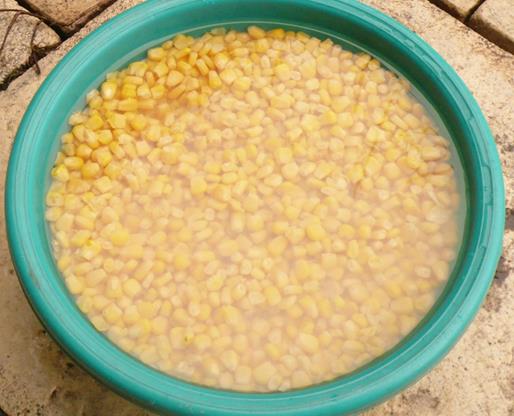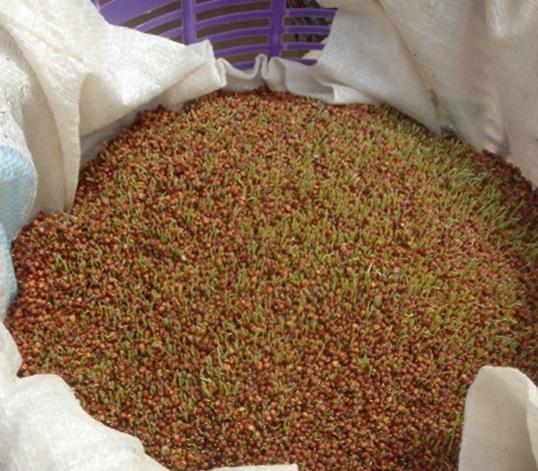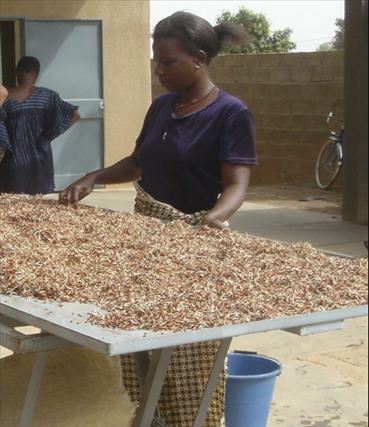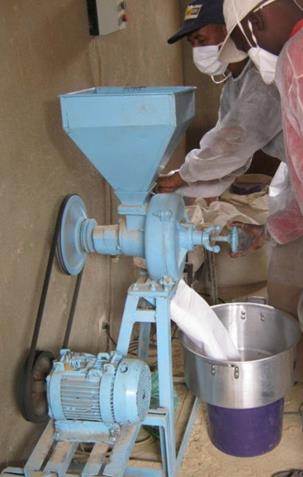Small
Illustrated
guidebook.
Making the « Malt for the Porridge »

bamisagora.org 04a-
18/05/2021
We call "Malt for the porridge" the ‘’flour’’ obtained from cereals Sprouted or germinated cereals are rich in amylases. Amylases have the power to liquefy thick porridge, without diluting it. The ‘’Malt for the porridge’’ is particularly rich in amylases. Thus, by adding a very small amount of this malt to the hot porridge, we obtain "Liquefied Concentrated Porridge" (LCP) The preparation of the “Malt for Porridge” is based on traditional cereal malting methods used for the preparation of local beers. In 'Artisan Production Units' (APU), 'Community Manufacturing Groups' (CMG) and for the family use, the making of the ‘‘Malt for the Porridge’’ is done according to the following process steps.
NB. Malt contains sugars, amylases, vitamin B. Malt does not contain alcohol. The document 04c of the site www.bamisagora.org , "Malt for the porridge - Preparation", gives further information on how to obtain a good quality ‘‘Malt for porridge’’. |
1°- Grain preparation - |
Choose good, living grains of, sorghum, maize (corn), pearl millet, paddy rice, . . . |
|
|
|
|
All varieties of cereal may be used to prepare malt. Choose well-stored grains, from the former harvest if possible, in order for all of them to germinate. Try out several different kinds of cereal and choose the one which prepares the most 'liquefying' malt.
|
|
2. Grain preparation - |
The weight of malt obtained is about half the weight of the grain set to germinate. |
|
Amount of BAMiSA FLOUR planned, in Kg |
|||
10 Kg |
25 Kg |
50 Kg |
1 Tonne |
|
Amount of Malt to prepare |
200 g |
500 g |
1 Kg |
20 Kg |
Weight of grains
|
≥ 400 g |
≥ 1 Kg |
≥ 2 Kg |
≥ 40 kg |
This table shows the weight of grain to germinate
according to the planned amount of flour.
3. Grain preparation |
Winnow, Sieve-calibrate, Wash and Sort the grain |
|
Calibrate with an adequate sieve enables to keep only the bigger grains |
During the washing, keep only the good 'heavy', |
|
4° Grain germination - |
Rehydrate the grain |
Soaking the grains in a little bit of water enables them to swell (to rehydrate them) and « wake » them up ! Depending on the grain, the soaking may need several hours. Change the water used for soaking and use lightly chlorinated drinking water. |
|
Be careful : Grains need air to live and germinate. |
|
5° Grain germination |
Maintain the grains damp by soaking them or regularly watering them during 2 to 5 days |
|
|
|
Maintain germination until the germ is clearly visible. Be careful : Cover the grains, place them in the shade, in a draft-free location, |
|
6° - Germinated grain drying - |
The germinated grain is to be thoroughly |
7°- Sorting - |
Sort to keep only the fully germinated grains |
|
|
|
The drying malt may attract flies. In that case, cover with cloth or a mosquito net. Be careful : When the weather is very damp, it is possible to finish the drying |
|
8° - Gribnding - |
Grind finely |
With a mill |
With a « peanut butter »
|
or on stone |
|
Be careful : Avoid the small leftover residual quantities of malt grist which could be |
||
9° - Sieving - |
Then sieve in order to eliminate fragments and hulls |

Fada N'Gouma Burkina Faso 2006
Sieve with a fine mesh sieve
10° - Malt checking - |
Prepare a porridge according to the « 1 + 2 + 3 Recipe» |
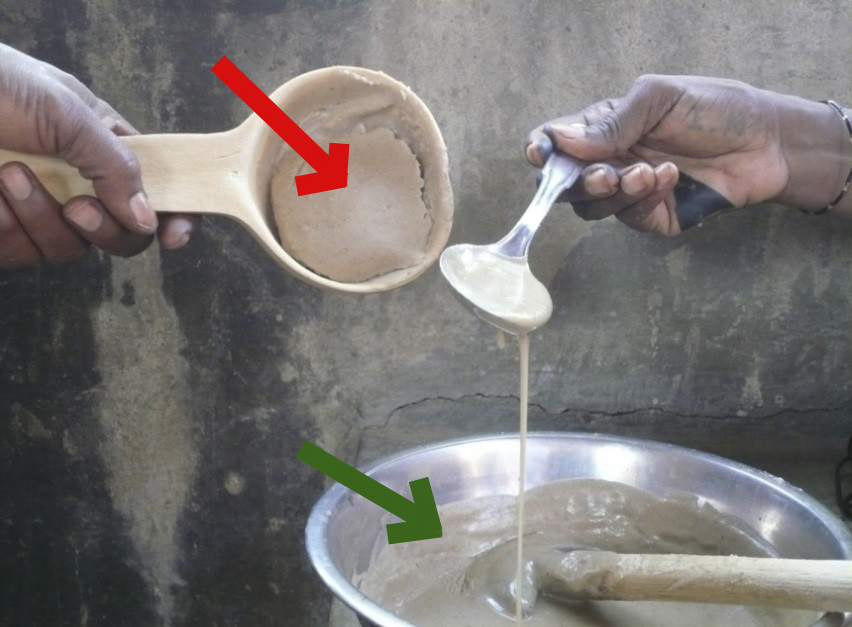
Koupéla Burkina Faso 2014
Thick porridge, before adding 3 pinches of malt.
The same porridge, one or two minutes after the action of the malt...
11°- Malt Packaging and Storing - |
Packaging |
|
|
|
The small bag of malt is
|
Package the malt in small airtight bags or 'sachets', easy to open and close. |
||
12° - Malt Packaging and Storing - |
Store in a dry place |
 |
The malt which is not packaged can be stored in pots. Well-dried and well-stored malt keeps its amylasic power during several months. It can be used to prepare Liquefied Concentrated Porridges (LCP's) with any kind of flours |
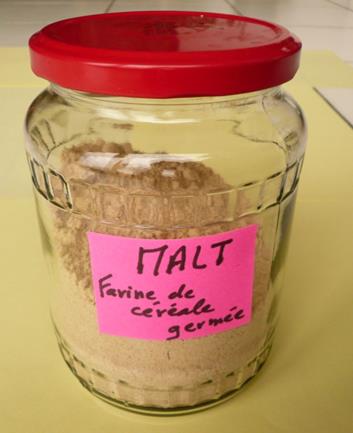 |
RECAP CHART OF THE PROCESS STEPS IN THE MAKING OF) THE "MALT FOR PORRIDGE"
Grain préparation |
1 | Choose good quality sorghum, maize, millet grain, paddy rice, |
| 2 | Determine the necessary quantity of grain |
|
| 3 | Winnow, Sieve-Calibrate, Wash and Sort |
|
Grain germination |
4 | Set to soak for a few hours |
| 5 | Set to germinate for about 2-5 days, maintainig the grains moist |
|
| 6 | Sort to eliminate no-sprouted grain |
|
Germinated grain drying |
7 | Dry well |
Grinding and Sieving |
8 | Grind finely |
| 9 | Sieve |
|
Malt testing |
10 | Prepare a porridge according to the « 1 + 2 + 3 Recipe».
|
| Malt packaging and Storing | 11 | Put the malt in the airtight sachets |
| 12 | Store in a dry place |
|
